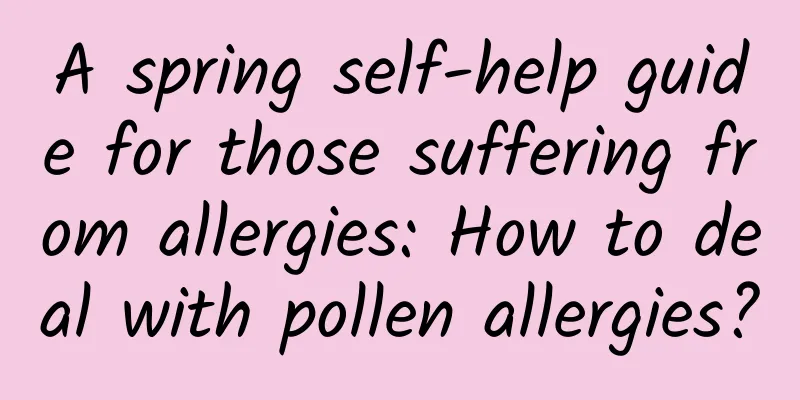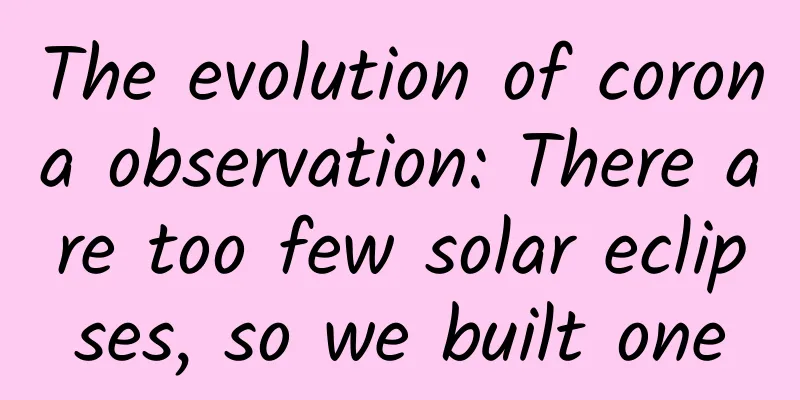A spring self-help guide for those suffering from allergies: How to deal with pollen allergies?

|
March is a good time to go out and enjoy the flowers, but many people experience itchy eyes and noses, sneezing and runny noses, and dare not go out without a mask. These symptoms are caused by pollen allergy. (Copyrighted images from the gallery, reprinting may lead to copyright disputes) 1 The biggest culprit of spring pollen allergies is not "flowers"? Pollen allergy, also known as "hay fever," is an allergic disease caused by inhaling pollen in the air, especially in spring and summer. In northern my country, spring pollen allergy generally starts in mid-to-late March and can last until mid-to-late May. But if you attribute the cause of allergies to the peach blossoms, cherry blossoms, apricot blossoms, magnolias, etc. that are in full bloom in season, you are wrongly blaming them. The "heartbreaking" truth is: what is more likely to cause allergies is not flowers, but the pollen produced by plants that do not look like they have bright flowers. In different seasons, the allergenic pollen is also different, so hay fever is seasonal. In spring, as the temperature rises, many plants enter the flowering period, thus releasing a large amount of pollen in the air. When the human body inhales these tiny particles, it is easy to stimulate the body's immune system to overreact, resulting in a series of symptoms. For plants, reproduction is their most important mission. Since plants cannot move, if they want to pass their genes to other plants, they need external forces. There are two common pollination methods, insect pollination and wind pollination. The pollination methods of the two are different, which also forms two different strategies. For insect-pollinated plants, their "matchmakers" are animals, especially various insects, so they have to attract their attention. Therefore, insect-pollinated flowers are often brighter and carry fragrance and nectar to lure insects. For wind-pollinated plants, they rely on unpredictable winds, which are full of more uncertainties. In order to increase the success rate of pollination, wind-pollinated plants will prepare more pollen and spores, exchanging quantity for "quality". (The mountain peach blossom, which is currently in bloom, is an insect-pollinated plant. Image source: Xinhua News Agency) Some scholars have analyzed the pollen and spore components in the air of the Beijing-Tianjin-Hebei region. In spring, the pollen in the air in these areas is mainly composed of tree plants such as Cupressaceae, Salicaceae and Betulaceae, especially Juniperus, which is known as the biggest "culprit" of spring allergies in Beijing in recent years. In recent years, affected by global warming, the pollination period of Juniperus has also tended to be extended. At the same time, due to increased exposure, atmospheric pollutants (particles or gases) also increase the allergenicity of pollen particles. In summer and autumn, plants such as Artemisia, Humulus, Chenopodiaceae, and Poaceae are the main ones. Although these plants belong to different families, their common feature is that their flowers are not bright and they are all wind-pollinated plants. On the contrary, those flowers that attract attention will not have too much pollen "wasted" in the air. 2 I have a cough, stuffy nose and runny nose. Am I allergic to pollen or do I have a cold? Pollen allergy not only causes nasal itching, sneezing, runny nose, and nasal congestion, but may also cause itching in the eyes, ears, and upper jaw, difficulty breathing, and paroxysmal coughing. In severe cases, there may even be sudden asthma, tracheitis, and cor pulmonale. What's worse is that many people who are allergic to pollen are also prone to food allergies. Under the stimulation of pollen, when allergic people eat some foods, they will induce more severe allergic reactions. This condition is called pollen-food allergy syndrome (PFAS). This situation is very common in the northern grasslands of my country. According to research, birch and Artemisia pollen are most likely to cause pollen-food allergy syndrome, and there are many types of food that cause allergies, including peaches, apples, peanuts, beans, celery, carrots and other fruits, nuts or vegetables. This "adding insult to injury" situation makes allergy sufferers even more tormented in the spring. Pollen allergy has similar symptoms to the common cold, and spring is the peak season for colds and flu, so people often confuse the two. Pollen allergy is usually time-sensitive, and corresponding clinical symptoms will appear during the pollen spreading season, such as itchy nose and eyes. Colds are also upper respiratory tract infections, and most patients may have fever or body aches, but generally do not have symptoms such as itchy nose and eyes. 3 How to deal with the unreasonable spring breeze? How can we avoid the troubles caused by pollen? Although we have not yet found a cure for pollen allergy at the current level of human medicine, we can try to reduce and alleviate the troubles caused by pollen allergy through the following methods. (1) For people with severe pollen allergy symptoms, it is recommended to do an allergen test to identify the type of pollen they are allergic to. After understanding which flowers and plants they are allergic to, you can choose to use nasal hormones, oral antihistamines and other drugs to control possible symptoms under the guidance of a doctor 2 weeks before the corresponding pollen season arrives. (2) Reduce contact with pollen. During the peak period of pollen transmission, you can try to reduce the number of times you go out to cut off allergens from the source. In addition to opening windows for ventilation when necessary, you should also keep doors and windows closed to prevent pollen from entering with the wind. If conditions permit, use an air filter to purify the air in your home. (3) Take good care of yourself. Wear a mask and goggles when going out, wear long-sleeved clothes as much as possible, avoid places with lush flowers, plants and trees, and avoid direct contact with pollen. Be especially vigilant on windy days. In the early morning and after rain, the pollen concentration in the air is relatively low, which is more suitable for travel. (4) Pay attention to personal hygiene. After returning home, change clothes and wash your body, mouth and nose in time. If you find allergic symptoms such as redness, swelling, and itching on your skin, you can use ice to relieve them. Keep the air humidity at home moderate and drink as much water as possible. (5) Always have anti-allergic drugs on hand. Under the guidance of a doctor, we can always have some relevant drugs on hand at home. Once we find that the symptoms of pollen allergy are serious, we should seek medical attention in time. The doctor can not only prescribe drugs scientifically based on our symptoms, but also identify the different allergens for each person and conduct specific immunotherapy based on the cause of the disease. This can also help us stay away from allergens as much as possible in our future lives and reduce the chance of allergies. Although pollen allergy is annoying and frustrating, as long as we take proper precautions, we can still reduce its impact on our bodies. There is no need to worry too much. As long as we adopt a positive lifestyle, we will surely usher in a spring full of hope. References: 1. Zhang Xiansheng, He Xueli (eds.). Botany. Beijing: China Agriculture Press, 2003.12. 2. Zhao Deyu, Ye Caihua, Wang Yufei, et al. Analysis of aerial pollen data in Beijing-Tianjin-Hebei region[J]. Acta Botanica Sinica, 2021, 56(6):10. 3. Jiang Nannan, Xiang Li. Pollen-food allergy syndrome[J]. Chinese Journal of Clinical Immunology and Allergy, 2023, 17(5):455-463. 4. Shao Jie, Luo Haiyan. Clinical and immunological study of food allergy syndrome associated with birch pollen[C]//The Second National Allergy Academic Conference of the Chinese Medical Association. DOI: ConferenceArticle/5aa48f62c095d72220ca6953. 5. Yang Qiongliang, Ouyang Ting, Yan Hong, et al. Research progress on pollen allergy[J]. Chinese Agricultural Science Bulletin, 2015, 31(24):5. DOI:CNKI:SUN:ZNTB.0.2015-24-028. 6. Life Times. The first wave of pollen warning in 2024! Some allergies disguised as colds. https://mp.weixin.qq.com/s/-4B5Js_3jaJCJydX2XMmlg 7. CCTV News. Pollen allergies are common, be alert if you have these symptoms → https://mp.weixin.qq.com/s/4zd2B2uxGVSDPbv0T9KVwg 8. Beijing Science and Technology News Agency. Pollen concentration in Beijing is "off the charts", and it's hard for "allergy sufferers". Let's see what experts from Peking Union Medical College can do → Author: Quasimodo in the Garden, Master of Agronomy, Science Popularizer Reviewer: Shi Jun, PhD in Botany, member of the Science Communication Committee of the Chinese Society of Botany |
Recommend
Unique design integrated with "Mango TV inside" - Seven V Box Experience Review
The importance of design to a product is self-evi...
Postpartum repair and slim waist postpartum body shaping Muquan two classes with notes
Postpartum repair and slim waist, postpartum body ...
Can brown sugar water, spinach, and wolfberry replenish iron? These four foods are the real iron supplements...
Author: Xue Qingxin, registered dietitian Reviewe...
Real-time display of iOS UI code writing effect
[[144355]] There are two ways to write iOS applic...
Charging piles have become a key factor in promoting electric vehicles. Can CNPC and Sinopec help build charging facilities?
At present, the country is vigorously promoting p...
Introduction to placing Wenchang Tower for people born in the Year of the Monkey in 2020
Introduction to placing Wenchang Tower for people...
A must-learn for founders and executives - Huawei Management Online Pre-Course
A must-learn for founders and executives - Huawei...
What are the new changes in Beijing's new energy vehicle subsidy standards?
On February 17, 2017, Beijing Municipal Science a...
The amazing "footless bird" almost never touches the ground in its entire life. It sleeps and mates in the air.
Have you ever heard of a bird that spends almost ...
4 "user retention" methods used by Facebook!
When talking about user growth, we often talk abo...
Is it true that African mercenaries hold signs and shout? How much does it cost to produce an African mercenary advertising video?
8,000 kilometers away from China and with a 5-hou...
How to perform exceptionally well during an argument?
Source: A Brief History This article has been aut...
How to become an operations expert, user growth system
Let’s first understand the difference between use...
Six major questions facing Apple's core products
As is Cook's usual style, he will certainly c...
Today is the Winter Solstice | Should we eat dumplings or glutinous rice balls?
In your hometown Should we eat dumplings or gluti...









